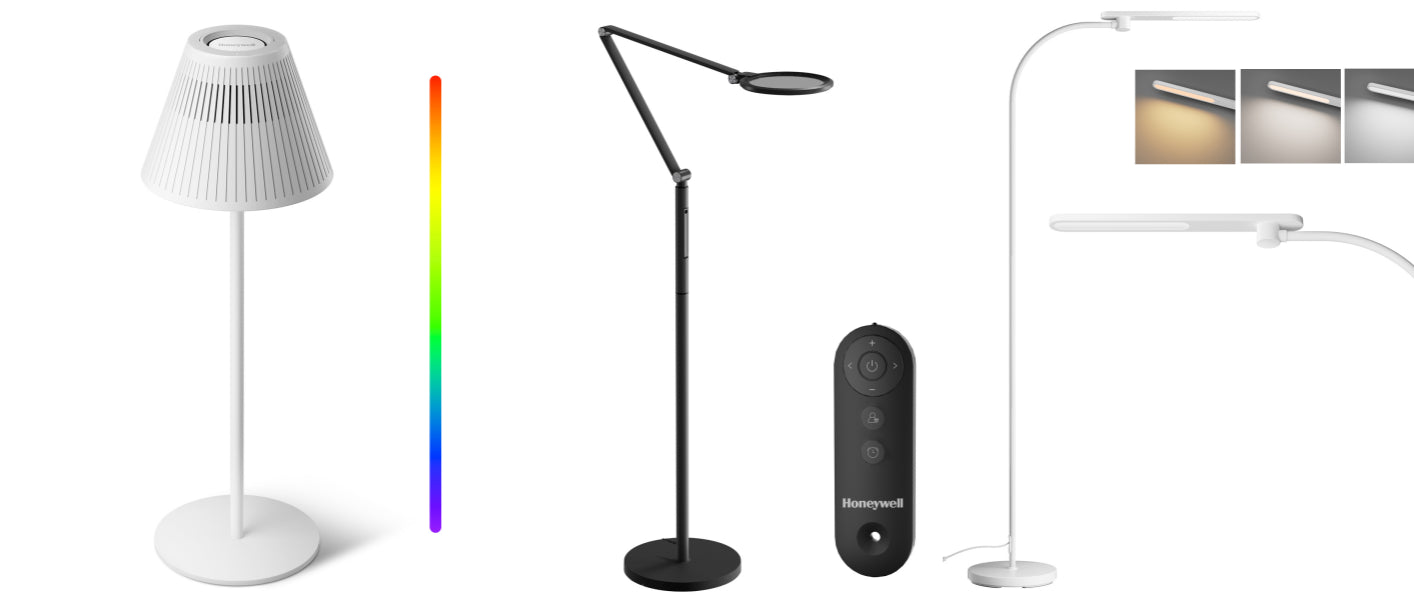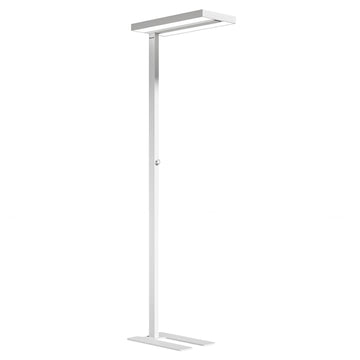Everyone winds down before bed in different ways. Some people read a novel, others scroll their phones, and some practice quiet meditation or light stretching. Whatever your bedtime ritual, the lighting in your bedroom plays a huge role. A good floor lamp isn’t just about style – it’s a tool that can help you relax or keep you alert, depending on what you need. In this post we’ll dive into why light matters for sleep, where to place a lamp in your bedroom, and how different age groups – teens, working adults, and seniors – have unique bedtime lighting needs. Along the way, we’ll weave in a few Honeywell SmartLighting floor lamps as real examples, describing their actual features (no fluff, just facts) so you can see how they fit into these tips. Think of it as science-backed advice meets lighthearted bedtime chat. Let’s flip the switch and get started!
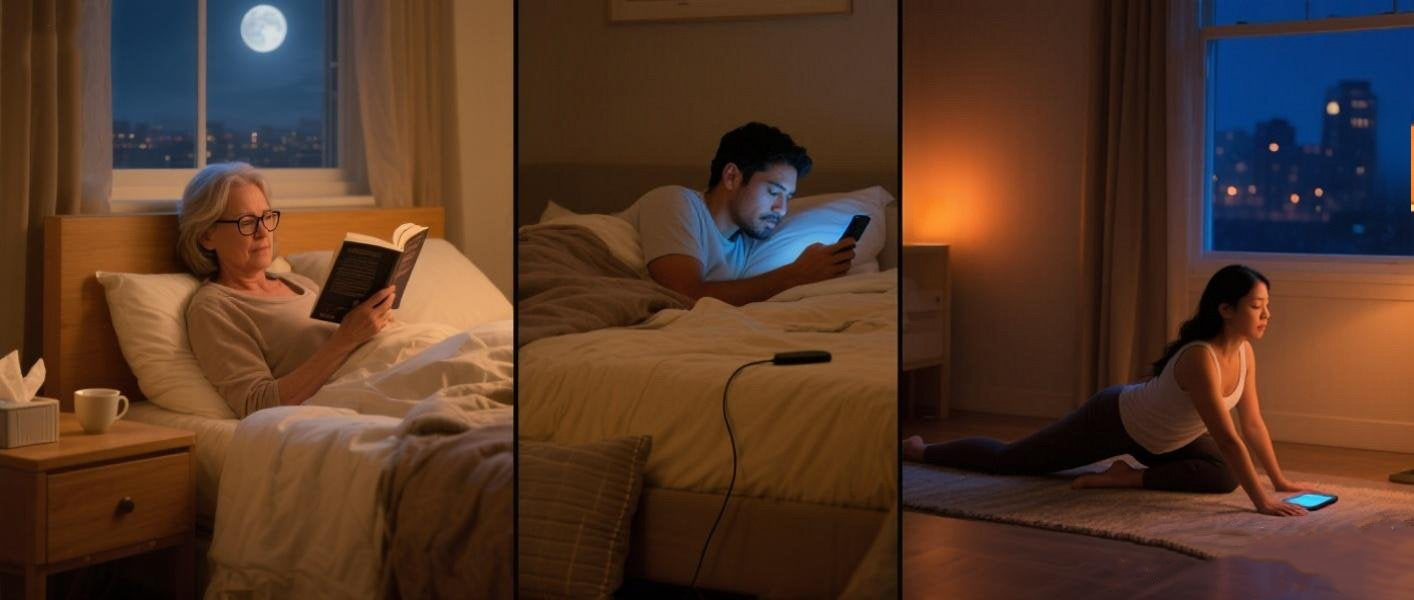
Lighting and Quality Sleep
Why Warm Lighting Matters
Bright office-style lights and glowing screens are great for work, but bad news for bedtime. Light is the biggest external factor that sets our internal clock (circadian rhythm). In fact, bright or blue-ish light in the evening suppresses melatonin, the natural hormone that makes us sleepy. Blue light – think LEDs and phone screens – has a significantly larger effect on melatonin and circadian rhythm than warm, long-wavelength light.
Too much bright/bluish light at night tricks your brain into thinking it’s daytime, making it harder to fall asleep and stay asleep. On the flip side, darkness signals the pineal gland to crank out melatonin, helping you drift off. Sleeping with a light on tends to fragment sleep cycles and reduces deep sleep. Even your eyelids can’t fully block light (closing your eyes isn’t enough). The bottom line: when it’s time for bed, dim the lights.
So what does this mean for your bedside floor lamp? You’ll want one that can go dim and warm. Many modern lamps are dimmable and let you choose the color temperature. Warm light (around 2700K–3000K, a cozy yellow-white) is soothing, while cool light (5000K+) is more energizing. For quality sleep, use the warmest setting and keep brightness low when you’re winding down.
Ideal Floor Lamp Placement in the Bedroom
Placement matters, too. A good rule of thumb is to put a reading lamp close to where you need it but not shining directly into your eyes. For example, place a lamp about 2–3 feet from your bedside so the light is gentle and indirect. The height of a floor lamp is usually around 5–6 feet tall. If the lamp is too low, it can glare in your eyes; too high, and it may not light your book or chair well. Aim for a height so the bulb is roughly at or just above eye level when you’re sitting or lying down.
Finally, consider background glow versus task light. You might use a small lamp right next to you for reading, and a dimmer, indirect lamp for general ambiance. Using some light rather than pitch darkness can be helpful when winding down, as long as it’s low-power and warm-colored. A floor lamp with a shaded top can give a soft overall glow (good for relaxation), while a separate reading lamp can be a bit brighter and targeted. The key is flexibility: dimmable, adjustable color, and positionable – these are all features to look for in a “floor lamp for bedroom” so it can serve multiple bedtime functions.
Lighting for Teens
Support for Study and Eye Comfort
Bedrooms often double as study halls for teenagers. Late-night homework or reading requires clear light, but teens also value feeling safe in the dark. A floor lamp can help on both fronts. For late-night studying or reading, bright, full-spectrum light is best to reduce eye strain. One example is Honeywell F4 Sunturalux™ gooseneck floor lamp. It has 96 high-brightness LEDs and emits 700 lumens while only drawing 12W. The F4 is designed to mimic natural daylight (it has a color rendering index CRI≥97 and full-spectrum LEDs), which means books and papers look clear and colors are true. Its 360° adjustable gooseneck (the lamp is about 77.5 inches tall) lets a teen aim the light exactly where needed. It blocks harsh blue spikes (RG0 blue-light protection) and is flicker-free, making it easier on sensitive eyes.
Creating a Safe Nighttime Environment
For younger teens or children who fear the dark, the sense of security from having a light on (even dimmed) can’t be overstated. A small bedside lamp or night light can calm nerves without fully waking the brain. Here, a cordless lamp like the Honeywell M1 comes in handy. The M1 is technically a battery-operated desk lamp, but it’s so portable that a teen can carry it from room to room. It has a built-in 5200mAh battery that lasts 6.5 to 35 hours depending on brightness. The M1’s light is full-spectrum with CRI≥95, and it offers 360° uniform illumination so there are no shadowy corners. It also has touch controls for dimming (10%–100%) and even fun RGB modes and four color temperatures.
In practice, you might keep a warm-glow mode on a teen’s lamp after lights out. A dim, amber setting provides just enough light for them to feel safe walking around, while still signaling to the body that it’s almost bedtime. When studying, switch to a bright white setting for clarity. Because the M1 is cordless and has a flat base, it can live on a desk, shelf, or nightstand – or even the floor in a child’s room – without cord clutter.
Another tip: pairing floor lighting with a simple night-light can leave a soft glow in hallways or bathrooms, which is particularly useful for teens who get up at odd hours. The combination of a dedicated study light and a gentle room light helps a teenager both stay focused while studying and navigate safely if they wake up.
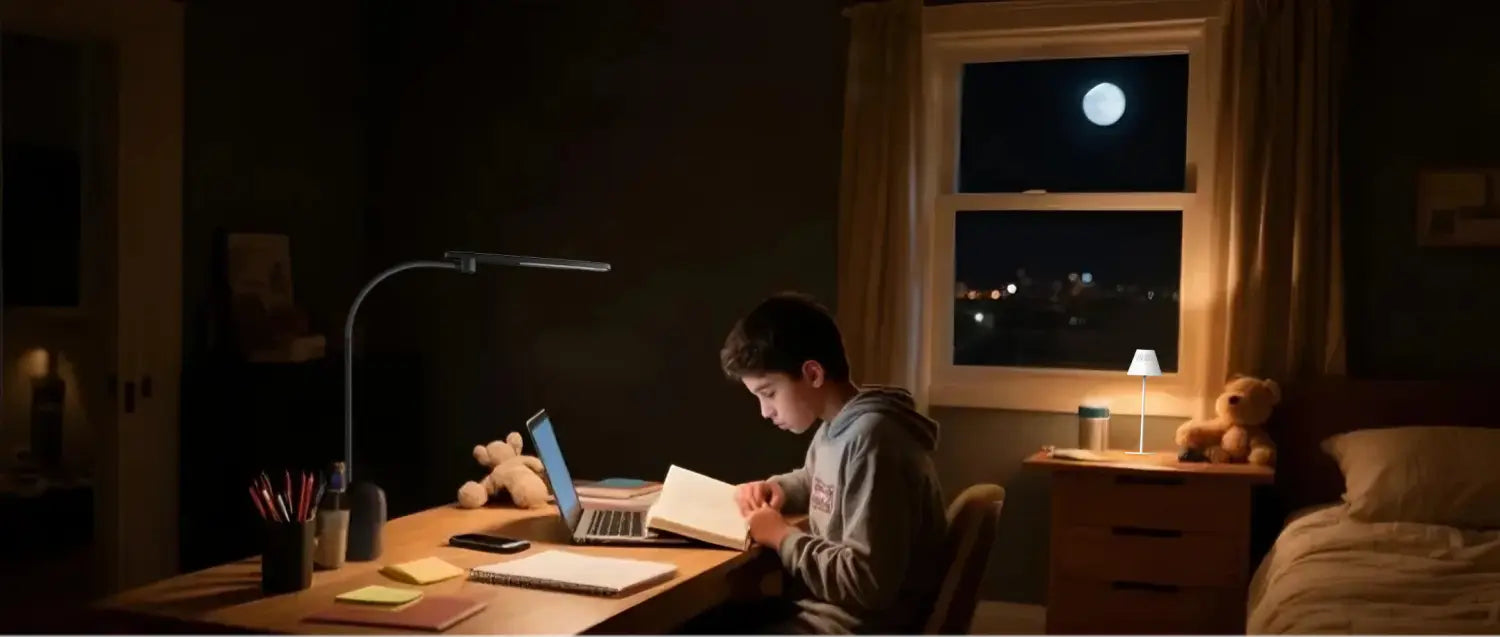
Lighting for Adults
Reducing Screen Fatigue and Eye Strain
Adults often face the opposite lighting problem of teens: too much screen time and eye strain from daytime. By evening, your eyes (and brain) need a break. A floor lamp can help reverse the trend of overexposure to bright light. For example, after a long day of staring at monitors or phone screens, you can switch on a lamp that provides eye-caring light. The Honeywell F01WT is a model aimed at exactly this. It’s a sleek 4-axis adjustable floor lamp (it pivots 70° at the base, 170° in the middle, etc.). It includes a remote control, so you can dim it or change color temperature while lounging. Its 96 LEDs span from warm (2700K) to daylight (5700K), and you can step down the brightness to a comfortable glow. Plus, its high-CRI LED panel is flicker-free and renders colors naturally.
All of this makes the F01WT a great reading lamp for bedroom or living room. Imagine winding down with a book – you can point the lamp exactly at the page for a crisp reading light, then use the remote to fade it way down and shift to a golden hue as you get sleepy. Because it’s made of sturdy aluminum and has a solid base, there’s very little chance of it toppling over.
From Work Mode to Wind-Down Mode
Aside from reading, consider other relaxing activities: meditation, light yoga, or sipping chamomile tea. A warm, dim floor lamp transforms your space into a calm sanctuary. Low illuminance and warm color temperature help relaxation and put us in the right mindset for sleep.
What about the keyword “desk lamp”? Many of us do work or reading at our bedside table too. A floor lamp can serve double-duty. In fact, the M1 lamp we mentioned (though small) is often used like a desk lamp on a nightstand or home office desk. You might use it to illuminate a laptop or journal in bed. Otherwise, if you already have a desk lamp for late-night work, make sure the floor lamp’s glow complements it – so the room doesn’t have one area in bright white light and the rest in darkness.
Last tip for adults: use dimmers! Many modern floor lamps (including all of Honeywell’s smart floor lights) have stepless dimming. That means you can fine-tune from 100% bright down to 10% or less. A smooth dimmer is better than an on/off switch because it lets you gradually wind down. You can even memorize your favorite low-light setting so it’s easy to return to each night.
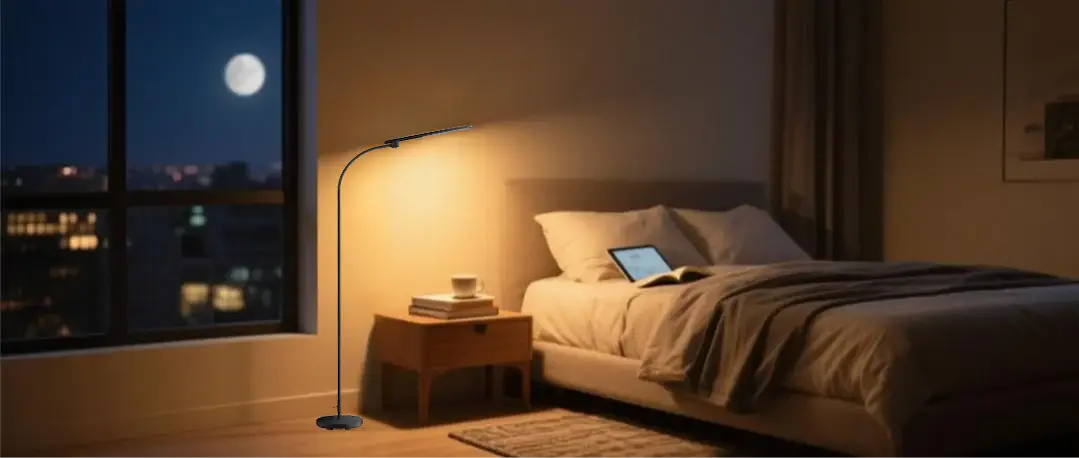
Lighting for Seniors
Enhancing Visibility and Fall Prevention
As we age, our vision changes and our nights often get bumpier. Proper lighting in an older person’s bedroom is crucial for safety and comfort. Even a minor trip can lead to serious injury. Improving ambient lighting significantly reduces fall risk for seniors. In one study, replacing a dim night-light with better ambient lights helped older adults stand and walk more steadily.
A floor lamp can help fill this need. You might install a motion-sensor nightlight in the hall, but also keep a floor lamp near the bed for getting up at night. Make sure it has a stable base (avoid thin-legged lamps that could tip). The lamps mentioned above (like the F01WT) have solid, weighted bases and sturdy poles – important features for safety. The height of the lamp should be such that the light covers the floor area. Downward-facing shades or diffusers are great for softly illuminating the path.
Choosing Easy-to-Use, Senior-Friendly Lamps
Color temperature matters here, too. Older eyes often tolerate warm light better at night. A lamp that goes down to 2700K (like F01WT) is ideal. Also, choose full-spectrum or high-CRI LEDs so contrast is sharp (easier to distinguish shadows and edges). For instance, Honeywell’s lamps use CRI>95 LEDs, meaning textures and stairs will appear more defined.
Placement tip: Keep a floor lamp within 3–5 feet of the bed (about 1–1.5 meters), so the senior doesn’t have to walk far to turn it on. Remote controls (as in the F01WT) are a boon – the person can adjust lighting without bending down. If that’s not an option, a touch-top lamp or a voice-controlled smart lamp might help.
Finally, longevity and ease of use matter for seniors. Bulbs should last a long time (most LEDs run 30,000+ hours), and controls should be simple. The lamps we’ve mentioned all have straightforward operation (touch or click dimming and color changing). If the senior has any visual or dexterity issues, consider a lamp like the M1
with a large touch area or the F01WT with a large remote.
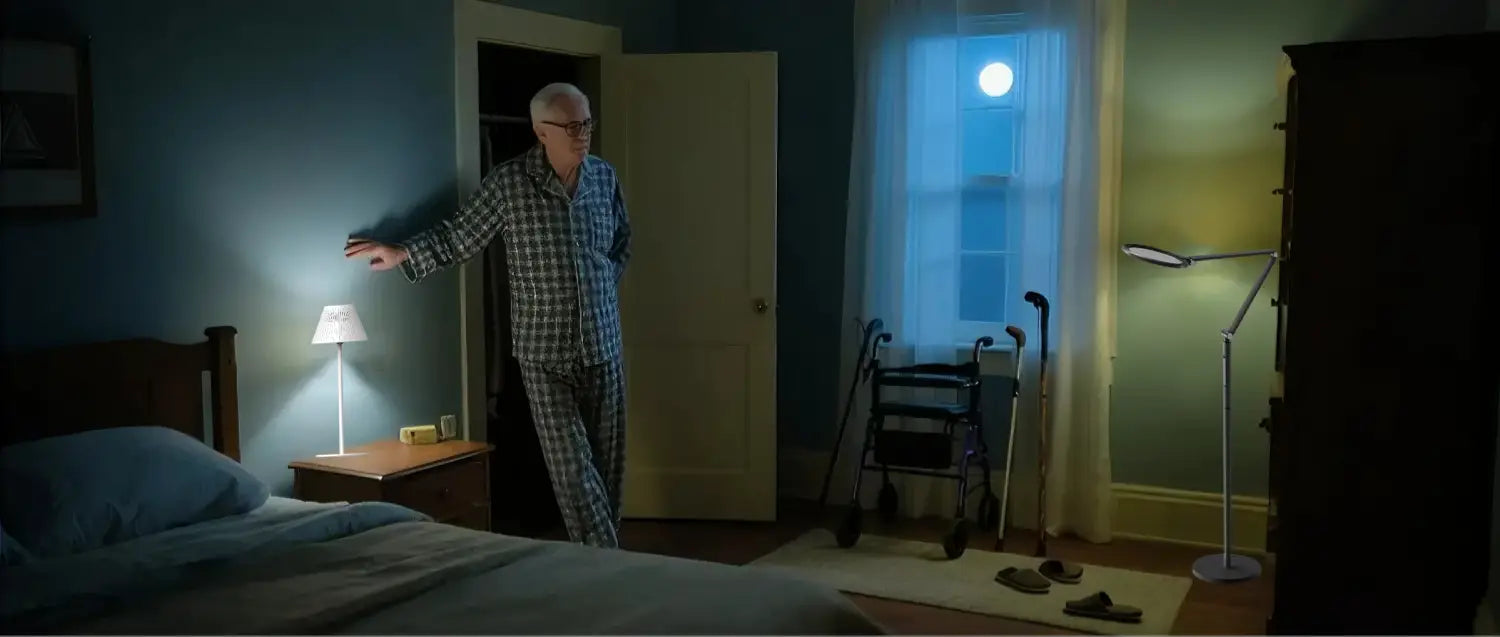
Conclusion
By combining bright, full-spectrum task lights with a dim, warm background lamp, an older adult can both see clearly and sleep soundly. A well-chosen floor lamp is one easy way to improve nighttime safety and comfort.
